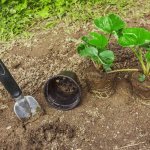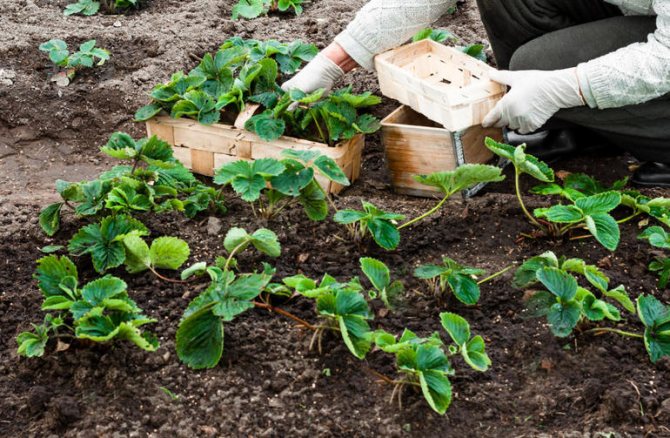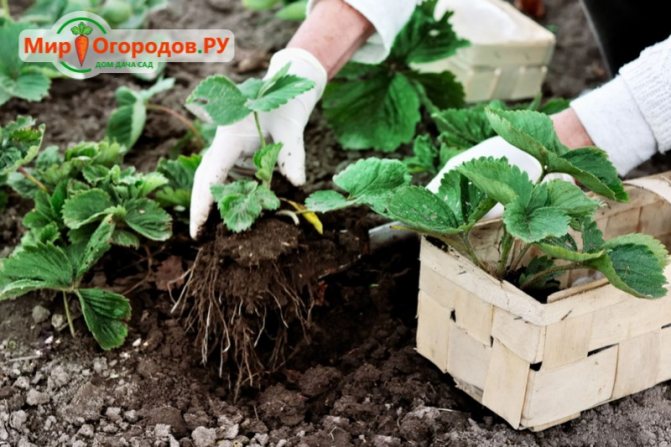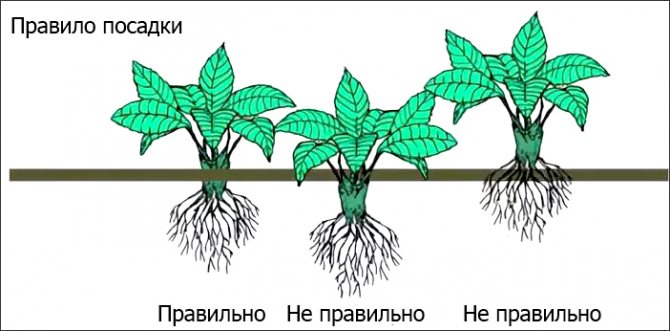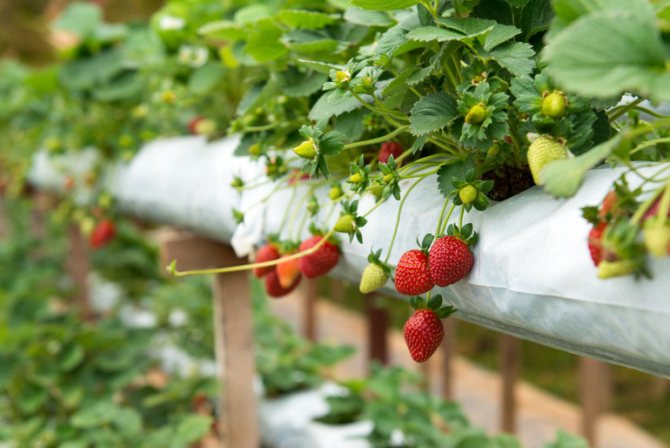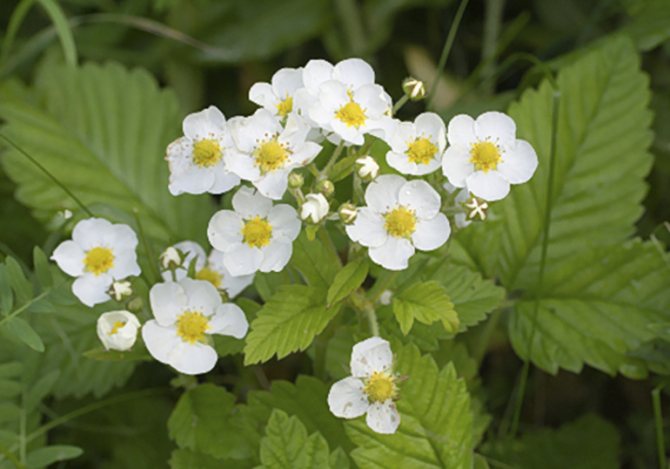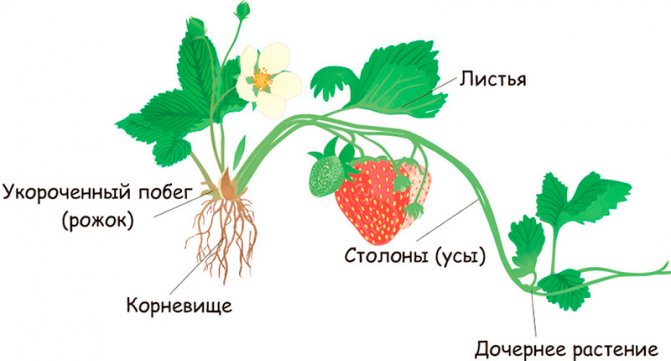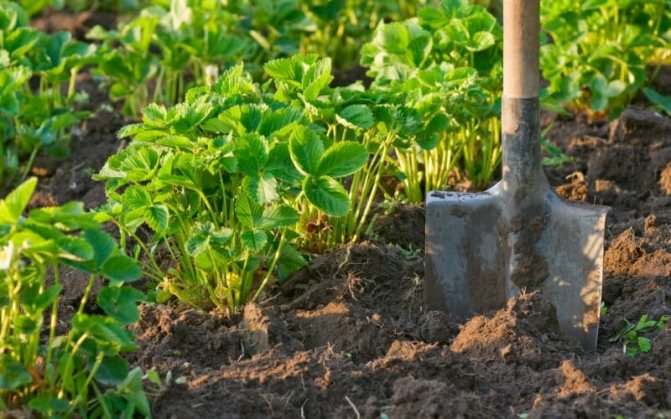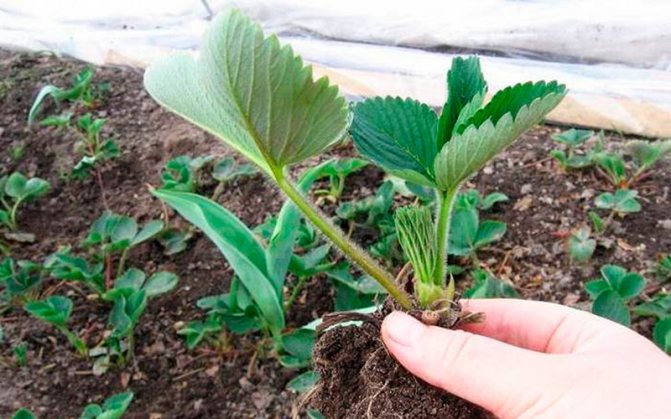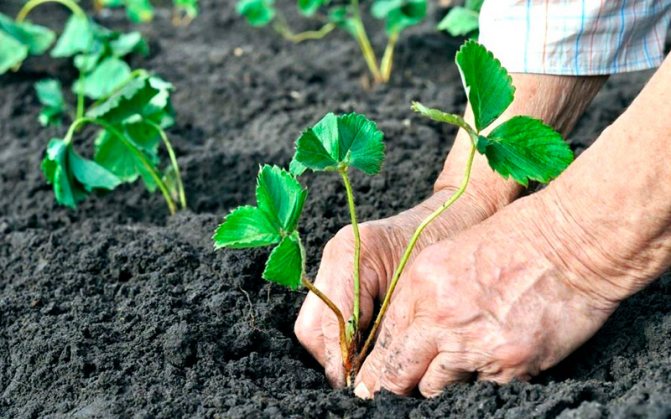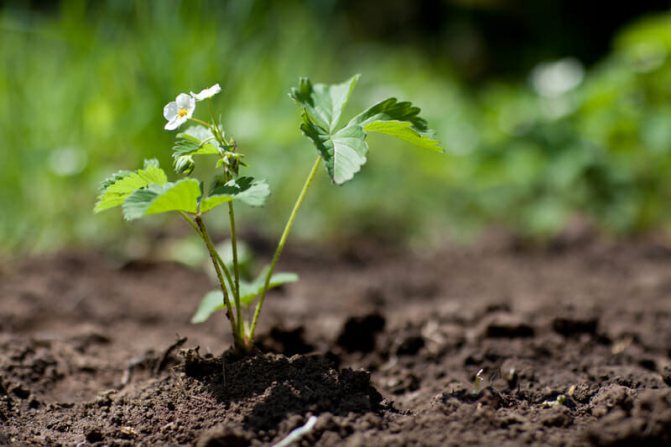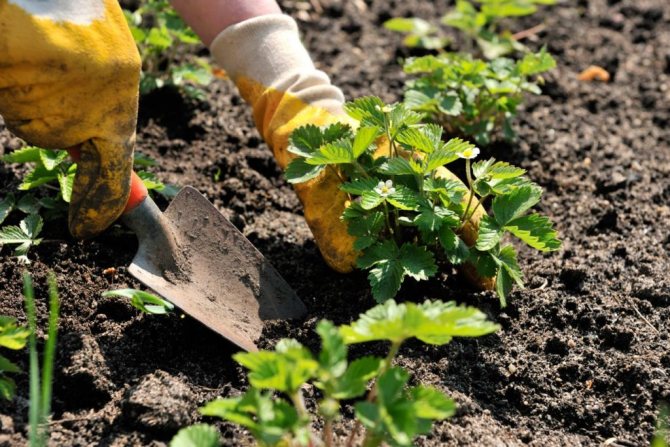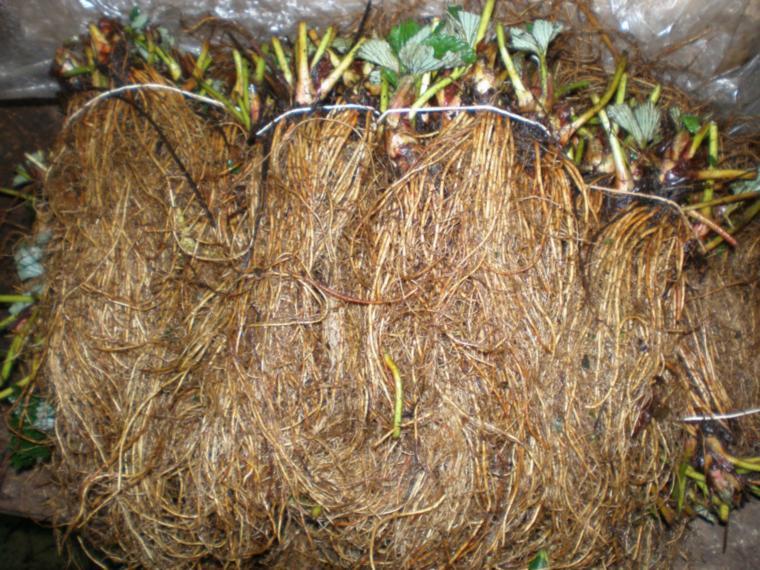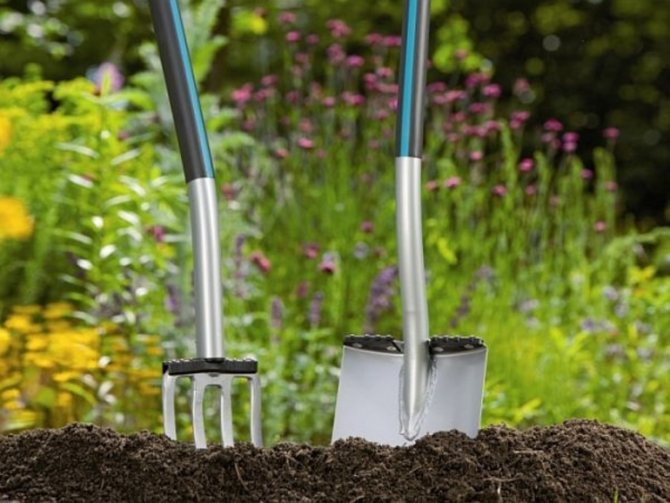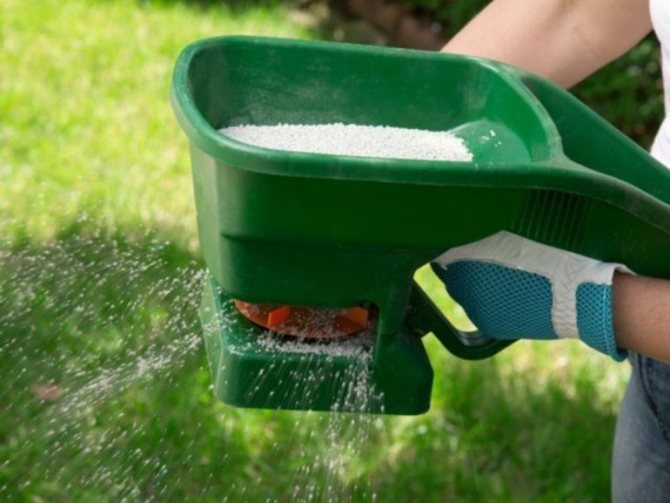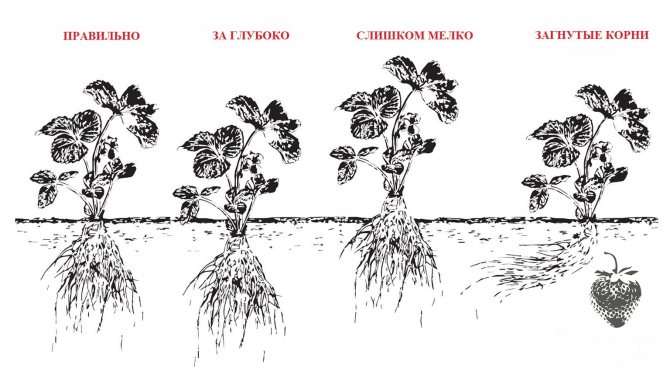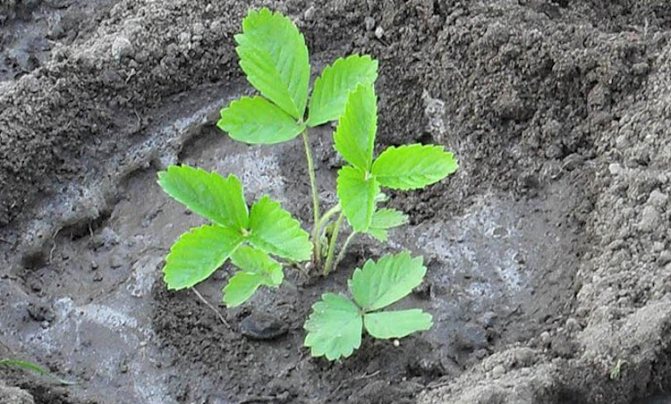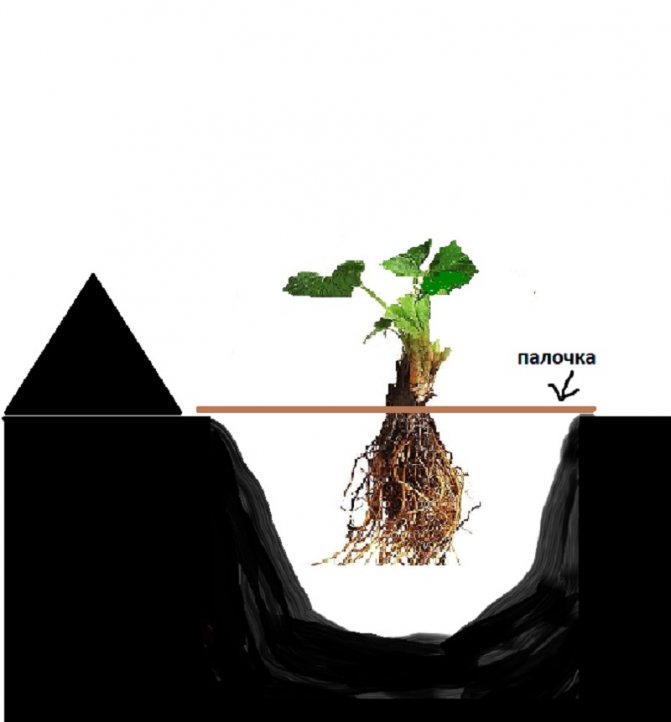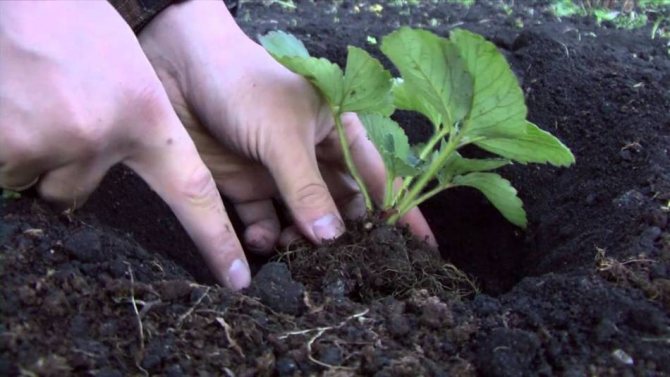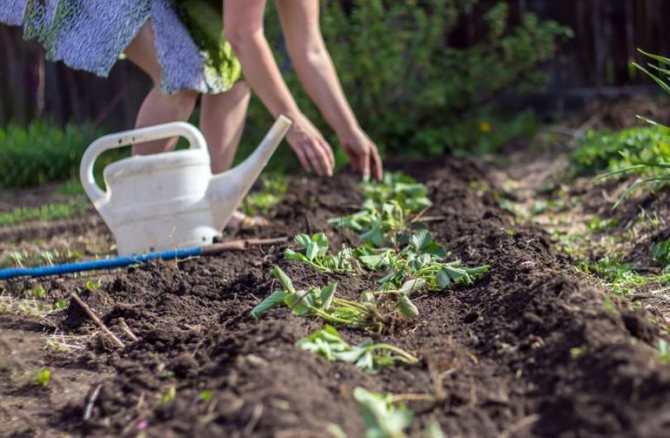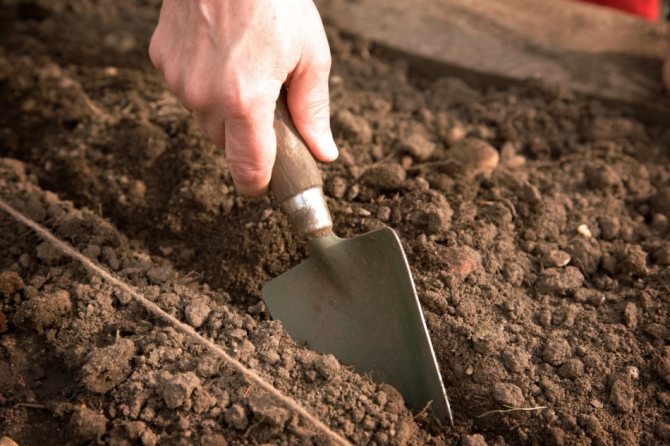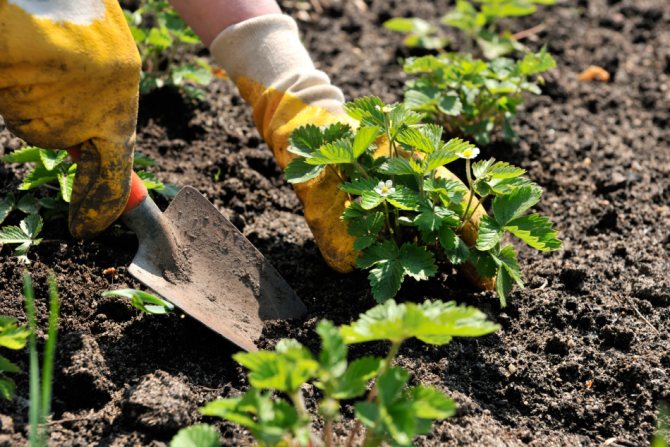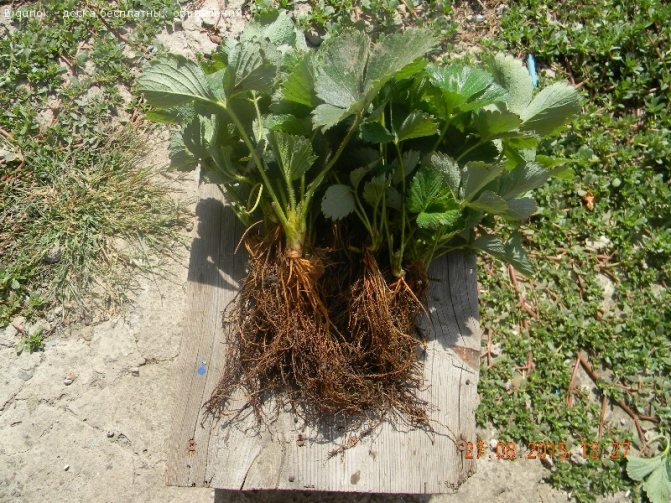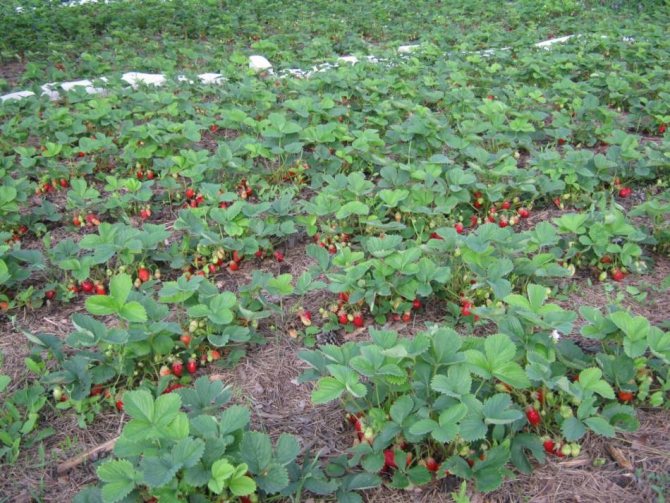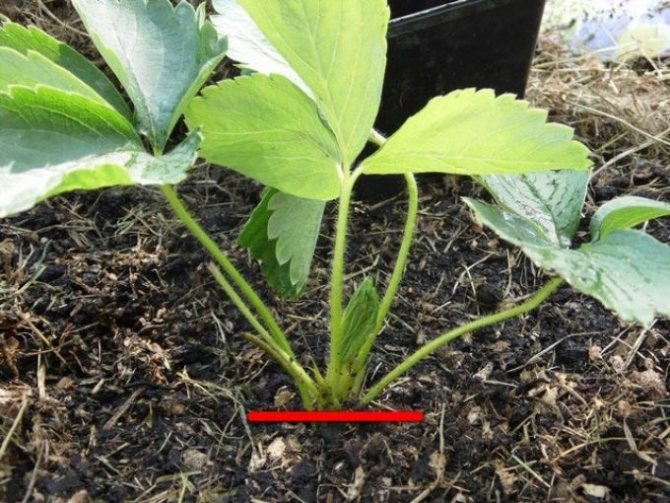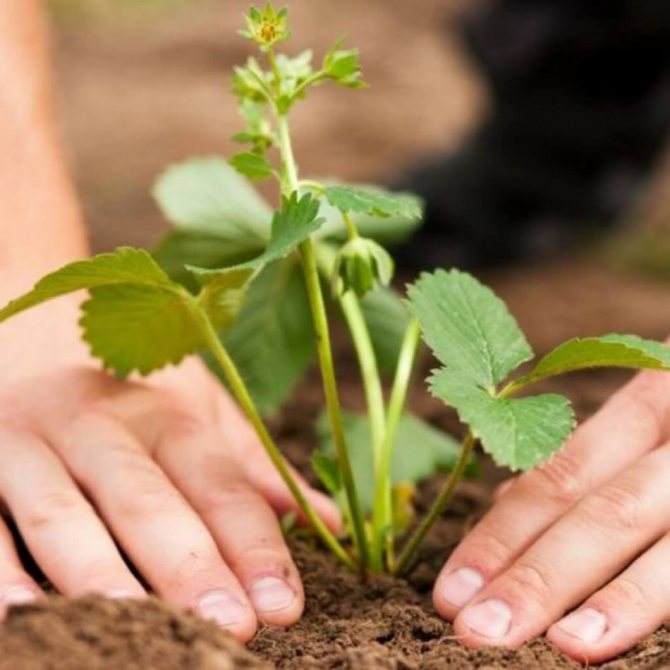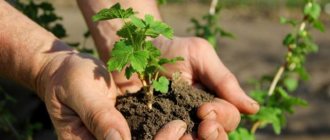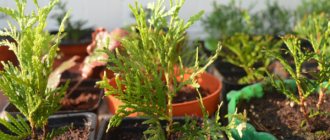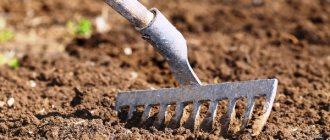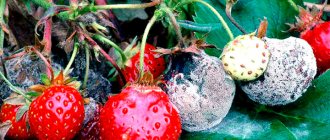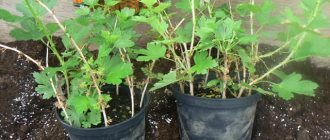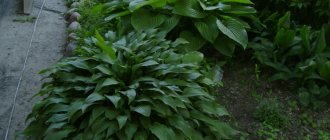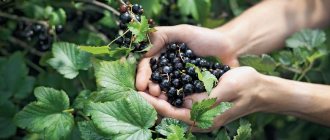»Gardening» Strawberry »Strawberry transplant in autumn - procedure scheme
0
32
Article rating
Transplanting strawberries in the fall is necessary to ensure good berry yields in a new fertile place. It is carried out at a certain time, taking into account regional characteristics. Some gardeners are additionally adopting the lunar calendar. With the right site selection and proper follow-up care, good results can be achieved.
Transplanting strawberries in the fall - procedure scheme
Why is it necessary to transplant
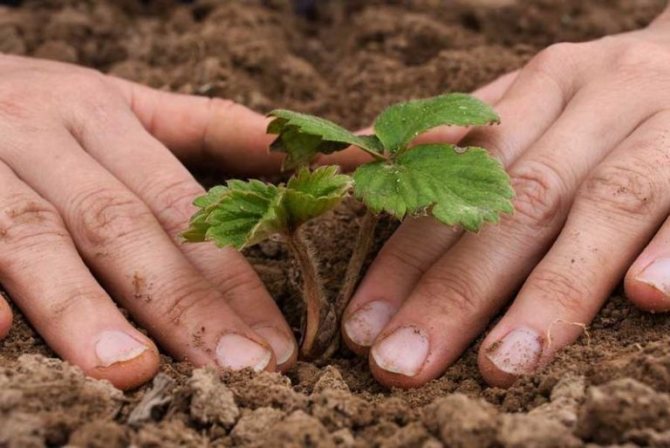
The main reason for transplanting a plant to another place is to further increase yields.
A necessary measure to rejuvenate the plantation and preserve the harvest is to transplant strawberries in the fall. It is important when moving to another place to divide the plant or plant it with a mustache. There is no point in replanting a whole bush in a new place, because an adult plant does not bear fruit as efficiently.
The main reasons for a transplant:
- Berries growing in one area for 3-4 years become small and lose their juiciness. The plant may stop bearing fruit altogether.
- The soil is depleted after a few years. The necessary micronutrients are not enough for the proper development of strawberries.
- Bacteria and fungus grow in the ground over time. Timely moving to a new place will help avoid diseases and plant death.
- The whiskers that extend from the buds rise higher and higher on the stem every year. During the winter period, they freeze, which leads to the rapid aging of the plant.
- The accumulation of groundwater and the formation of lowlands are the reason for moving the beds.
Features of care after cultivation
To maintain the transplanted number of seedlings, proper care is required. They need regular watering, loosening the soil, weeding, and pest control. In the absence of rain in the first week after transplanting, watering is carried out every other day. Gradually, the frequency of watering is reduced.
The newly formed mustache on young bushes is cut off so that the outlet does not waste energy in vain. In the event of an approaching frost, the plants are covered with a special material. Before the winter period, potassium-phosphorus fertilizing is applied. Experienced gardeners recommend applying at the roots:
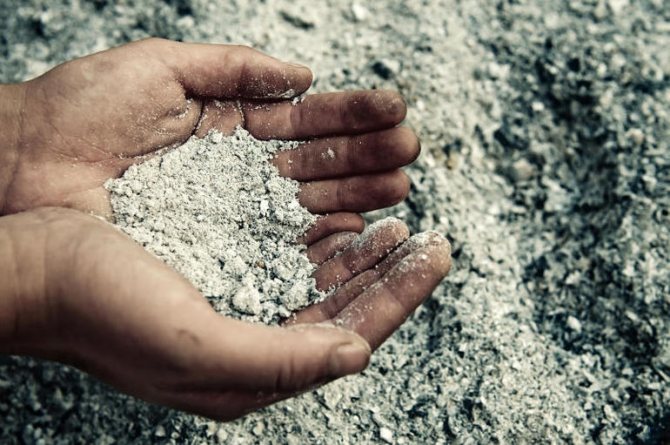

- Wood ash. It contains the required amount of potassium, phosphorus, as well as copper, zinc, iodine, boron, calcium. In the case of using dry matter on the soil surface, the roots will not receive optimal nutrition. For root application, a solution is made of 10 liters of water and 300 g of ash. Leave the resulting liquid for 4 days. After this time, a liter of infusion is added under each bush.
- Superphosphate. The substance is poured with boiling water and left for a day, stirring the solution periodically. On the second day, one liter of the resulting liquid is added under each root.
- Combined mixture. Take 20 g of nitroammofoska, 30 g of potassium sulfate, 250 g of wood ash and add 10 liters of water. The mixture is left to infuse for a day and 500 ml is added under each root on the second day.
To protect the root system from burns, only pre-moistened soil is watered with ready-made mixtures. If the transplantation technology is followed, then the plants will root perfectly in the winter.In spring, young bushes will give a rich harvest.
Yields usually decline four years after the start of fruiting. The berries become smaller and lose their original taste. To preserve a rich harvest, it is necessary to regularly renew the soil and remove old bushes from the beds. For transplanting, two-year-old bushes are taken. If young seedlings have gained color in the fall, then the peduncles must be removed.
Time for transplant
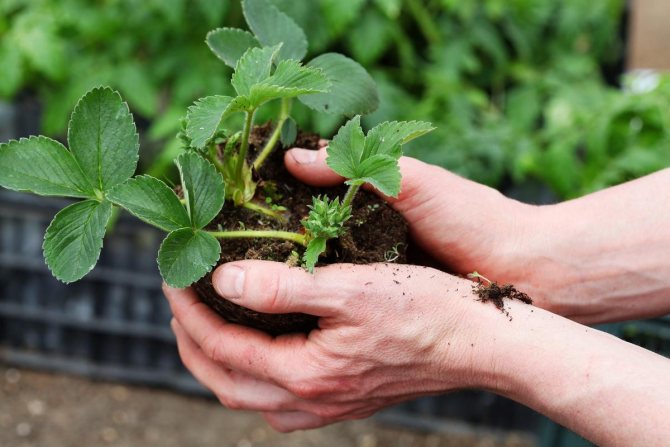

The time for transfer should be chosen based on the weather.
The most optimal time to transplant strawberries to a new place is in the fall. You can start gardening in September, but experts recommend paying attention to the weather and climatic conditions in the region. If the autumn is dry and hot, then it is better to postpone the transplant for a month. When transplanted to a new location in the fall, a rich harvest can be expected by the next season.
The advantages of transplanting in the fall:
- abundant and frequent rains will help take root;
- cool ambient temperature;
- the soil is warm and with high moisture;
- the plant will be able to grow stronger before frost;
- after transplantation, flowering is expected by spring;
- lack of aggressive sunlight;
- seedlings will require less maintenance;
- reducing the scope of work at the end of the season.
Strawberry plantation age
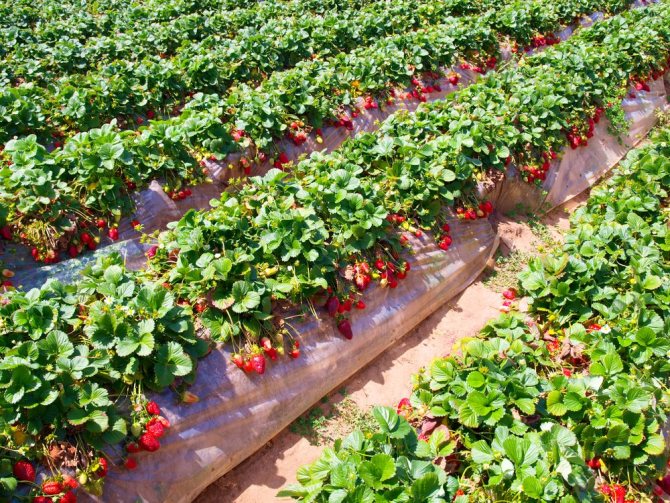

Most varieties and hybrids of the berry are productive in the second year after planting. Plants have a well-developed root system, and the stock of pests and diseases is still small. The average duration of the productive period of a strawberry plantation is 4 years. After the specified period, a change of place and rejuvenation of the bushes are necessary, which begin to bear poor fruit for 5 years.
Among the varieties with average indicators, there are specimens with a short productive period of 1-2 years, as well as a long one - up to 6 years. This is largely due to the genetic potential and indicated by the originators of the variety. However, the life cycle of the plantation is influenced by the resistance of the crop to diseases and pests, the climate of the cultivation region, as well as care.
Seat selection
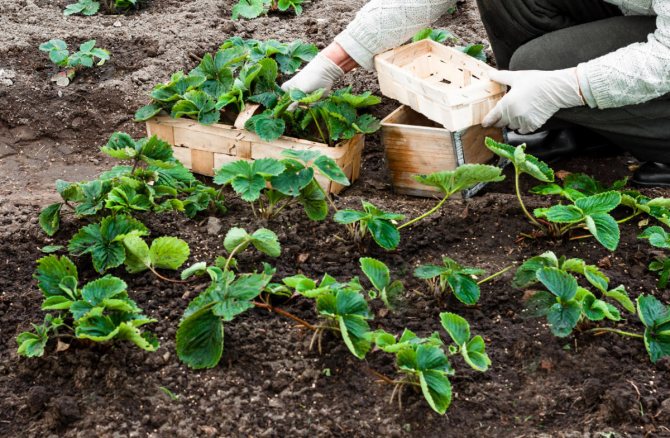

The best place to transplant a plant is a small hill.
Strawberries are very demanding to care for and susceptible to environmental changes. Therefore, the choice of a place for transplanting strawberries in the fall must be approached carefully. The berry will develop well in the beds where it previously grew: legumes, mustard, garlic, radishes, parsley and onions... These crops are beneficial to prepare the soil for planting strawberries. Cucumbers, tomatoes and potatoes, on the contrary, drain the soil.... Also, these plants have the same diseases. In the case when there is no choice, you need to pre-treat the garden from bacteria and feed the soil well.
The place for the beds should be chosen with a slope so that there is no stagnation of groundwater. The permissible distance to the roots is considered to be 60 cm. Excessive moisture can affect the condition of the roots and lead to the death of the plant. The slope should be approximately 2-3 degrees. It will be cold in the lowlands, the soil there warms up longer than on the plain.
It is recommended to prepare the site for the plant from the southwest side. Experience has shown that fruits ripen there earlier. The berry does not tolerate drafts. A quiet, sunny place will be considered the most optimal. Growth and flowering are also possible in the shade, but the taste of the fruit will not be so juicy and sweet.
How to rejuvenate strawberries without transplanting. How to rejuvenate strawberries and rejuvenate yourself
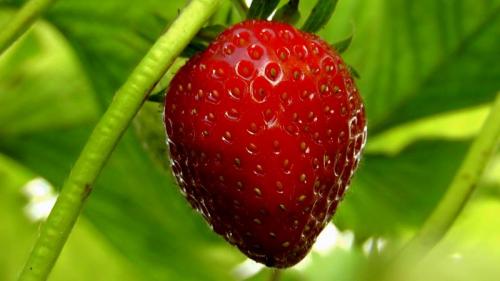

exclusive
Practical tips for growing strawberries from a connoisseur
Growing garden strawberries (strawberries) on the site is a great way to have natural products at hand for healing and rejuvenating the body.
“Strawberries, strawberries are a storehouse of vitamins, minerals, trace elements. If we talk about your own strawberry, organically pure and safe, then this is a seasonal berry.So how did the strawberries go - eat them daily! Apart from the recognized taste of strawberries, we note that the berries contain high concentrations of folic and salicylic acid, thereby increasing immunity and rejuvenating the body. - Says a professional gardener from the Moscow region Sergey Viktorovich Galkin. - There is an opinion that strawberries are a powerful aphrodisiac, so in romantic films, strawberries with cream symbolize passion. Beauticians recommend strawberry masks for women - for skin rejuvenation.
But in order for the strawberry to invigorate and rejuvenate us, we also need to rejuvenate it.
For three four years of cultivation, strawberry beds are filled with weeds, diseases and pests - which means it's time to rejuvenate the plantings.
There are many options for growing strawberries. In my opinion, it is worth considering the simplest and most effective ones.
1. Growing in boxes
The grass is removed.
A box is made on the ground from boards or other scrap materials. Width - see 80 - 90. Length - 5 m or more, as convenient. Height - from 30 cm.
Lutrasil or spunpond spreads to the bottom of the box - they block access to the box for pests living in the ground.
Further, the substrate is poured - a mixture of clay, sand, sawdust, chopped straw, peat, compost.
Rooted sockets are planted along the box in the substrate, and between them a groove is made with a depth of 20 - 25 cm.
From above, the box is covered with black lutrasil 60, cross-shaped cuts are made in the material at the location of the sockets, through which the strawberry will grow. The berries will not come into contact with the ground, which means that no one and nothing will either gnaw them or rot.
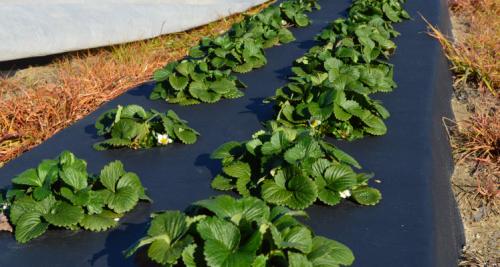

Landings in a box, warm up earlier and better than on a simple bed.
Black lutrasil further increases the temperature in the root zone and keeps it high at night. At the same time, lutrasil does not allow the substrate to overheat, freely passes air and water.
Lutrasil saves strawberries from slugs - they do not like to move on a warm rough surface.
Weeds do not germinate through lutrasil, lutrasil protects the soil from compaction during heavy rains - that is, no weeding or loosening is required. Accordingly, the use of any pesticides will not be required.
Planting in a box, it is almost impossible to fill it with water during heavy rain. In case of frost, it is easy to cover the box with white lutrasil without any additional supports or devices.
As we all know, watering with warm water is always recommended, but not always it is in the right amount. The groove between the rows of strawberries makes it possible to water with cold water, directly from a well or from a well. We pour directly into the groove, right through the lutrasil, and until it reaches the roots, the water temperature will equal the temperature of the soil. And if desired, drip irrigation can be placed in the groove. Yes, planting is somewhat more troublesome than traditional, but for the next 3-4 years, you will only have to water the garden and harvest, without fear of attacks from diseases and pests.
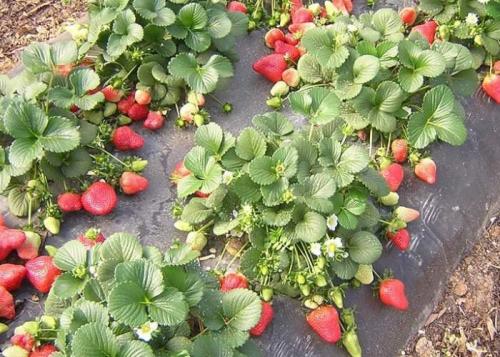

Growing in containers
Actually, a container is a mobile, portable box that has all its advantages. Plastic containers are sold - rectangular, and you can take plastic buckets of 8 - 12 liters. Each can accommodate 4 to 6 rooted sockets.
But containers also have additional benefits. For example, containers of strawberries can be brought into an unheated greenhouse in February, when they are not yet used for vegetables. And at the end of April, when the time comes to plant vegetables in the greenhouse, take the containers outside and get the berries a month earlier than usual.
And vice versa. For the winter, place the containers in a shady spot where the snow melts last. In winter, pour more of a snowdrift on the containers, tamp and cover it well with straw or branches, peat.These plantings will come out from under the snow a month later than usual, respectively, and you will receive berries when they all have already left.
Soil preparation
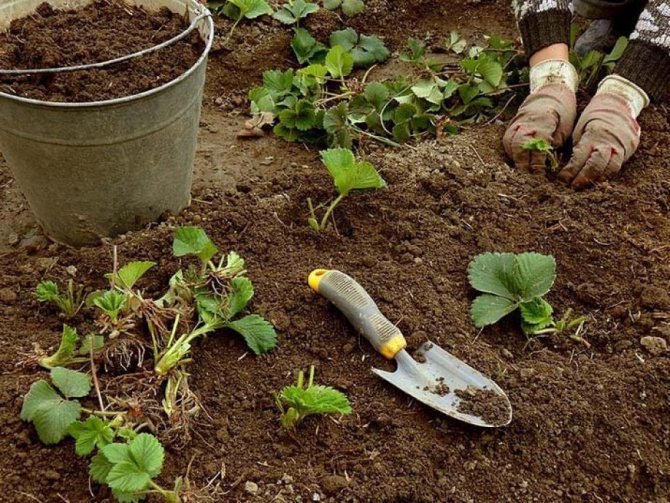

Ordinary manure is suitable as fertilizer.
The correct selection and preparation of the soil is essential for the subsequent plant growth and yield. The berry will grow well in black soil and loamy soil. Transplanting strawberries into sandy or clayey soil will reduce the quantity and quality of the crop. In a wetland, the plant will die.
Before replanting to a new place, it is necessary to prepare the soil. In the case of clay soil, it is necessary to add peat or manure. It is necessary to prepare sandy soils several years before transplanting by planting legumes. To improve the composition and enrich it with useful substances, it is recommended to add a mixture of humus, superphosphate and potassium fertilizer. A bucket of top dressing must be added for every square meter of the surface.
There should be no insect larvae in the garden. If pests are found, then urgently need to process the soil. After preparing the soil, the bed is dug up and loosened well. The day before planting, it is necessary to water abundantly with water. The formation of the holes does not need to be done in advance.
Planting under black covering material
This material is a black film with a thickness of 100 microns. You cannot use a thinner material, otherwise weeds will be able to seep through it.
Algorithm for planting under black covering material:
- Place this material on the beds, press on the edges with bricks and cover with soil.
- Make cuts in the black material, and dig holes under them, plant strawberry seedlings in them.
- Be sure to remove the mustache from the plant, otherwise they will take root under the film, and then it will be very difficult to put the plantings in order.
This material is removed for the winter.
Summer residents are sure that black covering material helps to increase the amount of strawberry harvest. This is due to the fact that the covering material heats up quickly from the sun's rays, and this significantly accelerates the growth of berries. The only drawback of such a system is inadequate watering. The slots are very small and moisture does not get well to the root system.
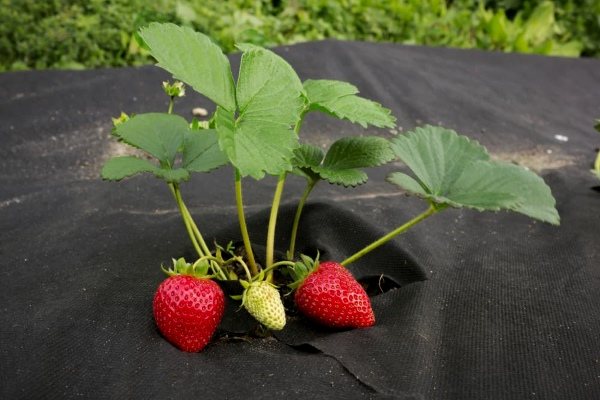

Seedling requirements
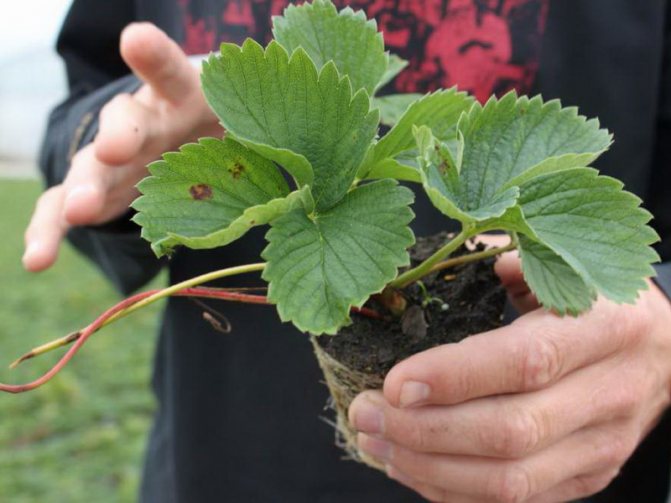

When transplanting, special attention should be paid to the rhizome of the plant.
Seedlings must be selected correctly in order to get strong and healthy plants in the future. Otherwise, transplanting strawberries will not give a good result.
Criteria for choosing seedlings:
It is important to pay attention to the size of the root system. The base of the root should not be less than 6 mm, and the length of the roots should be about 7 cm. The seedlings should have healthy stems without spots and altered appearance. It is required to give preference to plants with 3-5 leaves per bush. The best option would be to choose rosettes at the base of the plant. If the rosette is small and the root system is developed, then there will be no problems with rooting. Strawberries should be preferred for no more than 3 years. The older the plant, the worse the yield will be.
If reproduction occurs with antennae, then this criterion is not taken into account. Only the first two antennae need to be rooted. Others are removed so that the plant is not depleted.
It is advisable to transplant seedlings immediately after digging up. If there is no possibility or it is planned to transport the bushes, then the earthen lump must be wrapped in cellophane or a damp cloth. In the case when the work will be carried out on the site, the seedlings can be dug in a dark place.
What to look for when buying seedlings?
Strawberry bushes will take root more quickly in the open field if they were grown in individual pots. But you need to be sure that the plant is not stuck in the cup before selling it.This can be checked in a simple way: inspect the bottom of the cup, if the tips of the roots are visible from the drainage hole, then the plant is rooted in this cup. You can take it.
It is safer to buy seedlings with open roots. Of course, it will take more time for rooting, but we will be sure of the quality of the planting material. A quality strawberry seedling looks like this:
- The fibrous root system with processes reaches a length of up to 8 cm.
- The roots should be white or slightly darkened.
- The root collar must be larger than 6 mm.
- The seedling must have at least 3 developed leaves.
You should also pay attention to the storage of planting material. The roots should be slightly damp. This means that the seller periodically sprayed the seedlings with water.
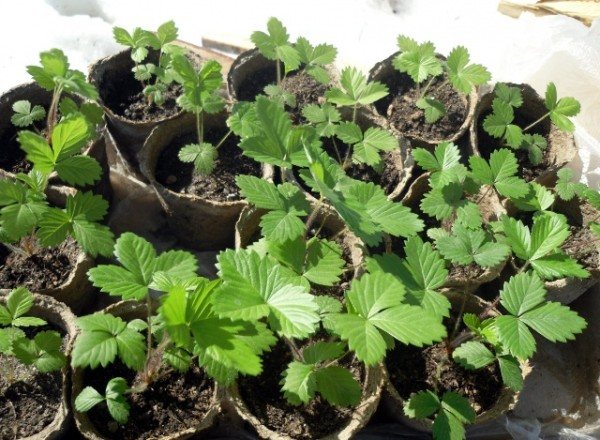

Examine the purchased seedlings at home. If there are roots that are too long, then shorten them to 10 cm. So that the seedlings take root faster, dip the root system in a clay mash. She prepares like this:
- fill the orange clay with water so that it is only slightly covered with water;
- add "Karbofos" from pests and a stimulator of root growth to the resulting mixture;
- stir until smooth.
In this mixture, you need to lower the roots for strawberry seedlings. They will be protected from drying out, and their survival rate will improve.
You may be interested in: Planting and leaving hosts in the open field
Planting methods
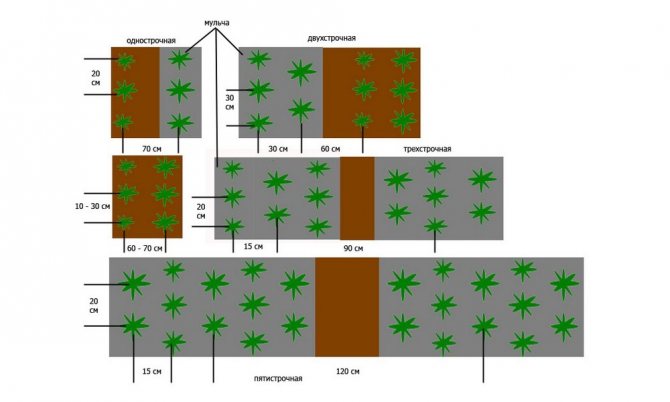

The location of the strawberries can be selected based on the terrain
There are several ways to arrange holes outdoors:
Planting in rows is the most popular way... The distance between the plants should be 25 cm, and between the rows at least 60 cm. Two-line planting of seedlings recommended in areas with limited space. The only difference is the distance between the lines, it is 30 cm. Staggered Disembarkation will require increased care and dexterity from the gardener. Previously, in order not to be mistaken, you need to outline the places of the proposed holes.
Each gardener chooses the optimal arrangement of bushes based on his personal preferences. The main thing is to observe the minimum distances so that the plants do not interfere with each other to grow and develop correctly.
Pros and cons of transplanting in the fall
Having learned when you can transplant strawberries in the fall, and in which month it is best to carry out preparatory measures before planting, you should also know about the positive and negative aspects of transplanting in the fall.
Plants planted in the fall will be able to harvest the next harvest season. But there is a risk that the bushes may not have time to take root before the onset of cold weather. In this case, the plants may die, and there will never be any berries on them.
For this reason, gardeners prefer to transplant strawberries in the spring. Strawberries transplanted after spring frosts are guaranteed to be able to take root, but you can not expect a harvest from them for this harvest season.
Transplant instructions
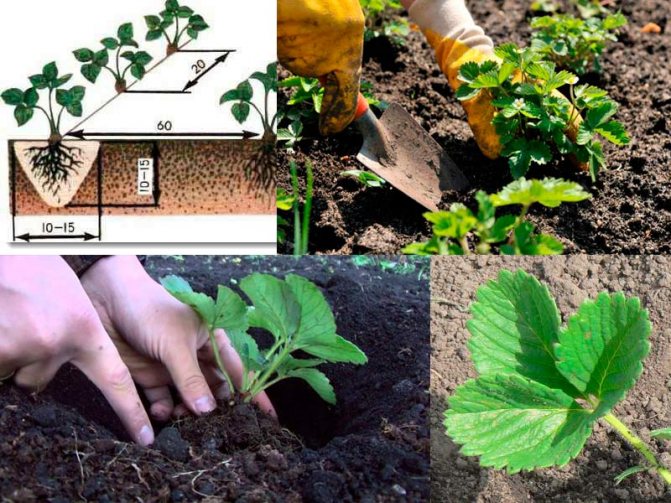

It is more effective to transplant strawberries with an earthen clod. In this case, the plant will quickly take root in a new place. The whole process consists of several stages. It is important to stick to consistency.
Step-by-step instruction:
- Initially, it is necessary to prepare seedlings, fertilize the soil.
- The garden bed is watered with abundant water per day and allowed to dry.
- Next, outline the approximate location of the holes and dig them out.
- After that, the seedlings are placed in a mixture of water and manure.
- Seedlings are planted in the hole very carefully so as not to damage.
- The next step is to sprinkle the roots with earth.
- Then the soil under the bushes is compacted and watered.
- The final step is mulching with sawdust or pine needles.
In the case of a bare root transplant, the plant can be soaked in a rooting solution or disinfectant. If there is abundant foliage on the seedling, then it is cut off.It is optimal to leave 3-4 sheets. The plant is able to get stronger and take root within two weeks.
How to properly transplant strawberries to a new location
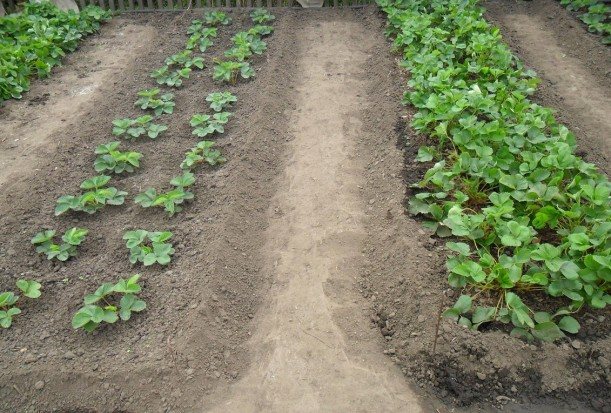

The strawberry yield grows due to the appearance of new leaves, whiskers and peduncles on the bushes. After 3-4 years, the growth process in plants stops, the number of berries decreases, they lose their taste and become smaller. Over the years, the soil under the strawberries is depleted, diseases accumulate in it, and pests multiply.
To obtain a good harvest of strawberries, regular soil renewal and the removal of old bushes from the beds are required.
For transplanting strawberries, 2-year-old bushes are taken. Younger plants have not yet matured, and 3-4-year-old bushes do not give a good harvest.
Strawberries are propagated by whiskers and bush division.
Planting is done in open ground or under a black film or agrofibre.
In regions with unstable temperature indicators, it is better to plant seedlings under film or agrofibre, which protect the plants from negative environmental factors.
Mustache landing
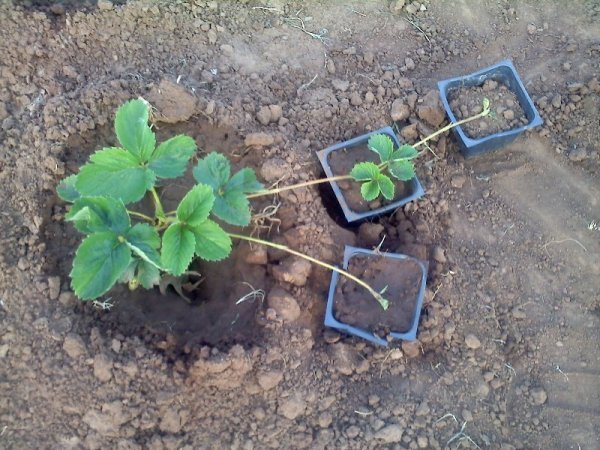

From mid-June to July, strawberry bushes produce whiskers. For transplanting strawberries with a mustache, healthy, strong bushes with a strong root system, developed leaves and a core are selected.
The strongest whiskers growing closest to the mother bush are left on the mother bushes. Other peduncles are pruned so that the plants do not waste energy on the development of new bushes. The whiskers, if they did not have time to take root, are sprinkled with earth and, when 3-5 leaves appear, are transplanted to a new place.
Site preparation
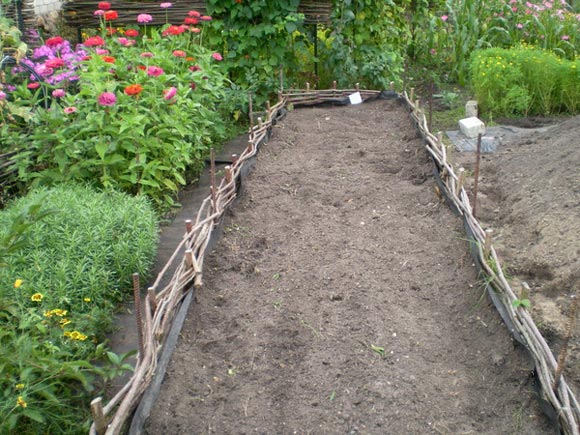

For planting strawberries, a light, not flooded area with loamy and slightly acidic soil is selected.
- If on the site there is peat land per square meter of beds, 1 bucket of river sand and 1 bucket of land are brought in.
- A bucket of clay chips, 5 kilograms of rotted leaf litter, 5 kilograms of humus, compost or peat are brought into the sandy area.
- 1 bucket of sand, 1 bucket of peat and 1 bucket of rotted humus are added to clay soil.
- With a high acidity of the soil, wood ash or dolomite flour is introduced into the ground.
The best precursors for strawberries are onions, garlic, legumes, grains, beets, and carrots. Poor prior crops are eggplant, cucumber, peppers, tomatoes, physalis and potatoes.
A plot for strawberries is prepared in 1.5-2 weeks for planting. Complex fertilizers, steamed sawdust or rotted humus are applied to the soil cleared of weeds and roots. The soil is dug to a depth of 25 centimeters.
Before planting strawberries, 10-15 kilograms of rotted humus, a glass of wood ash, 25 grams of potassium chloride, 40 grams of superphosphate are introduced into the soil per square meter.
The soil is dug up again, leveled with a rake and treated with a solution of potassium permanganate for disinfection.
You need to transplant strawberries in cloudy weather or in the evening.
Landing
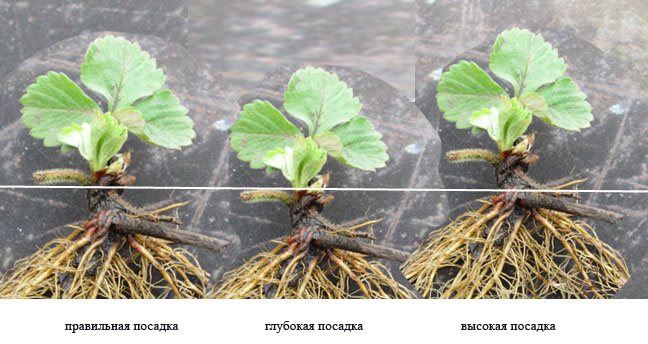

If the site allows, then the best scheme for planting strawberries is a one-liner. Bushes in this case are planted in 1 row, in increments of 25-30 centimeters. The row spacing is 80 centimeters. This planting pattern makes it easy to care for and access the strawberries from 2 sides during harvest. The whiskers that appear later make the landing more dense.
In a small area, strawberries are planted in 2 lines. The sockets are planted in steps of 30-35 centimeters in one row, the same distance is maintained between the lines. The row spacing in this case is also equal to 80 centimeters.
Caring for such plantings is more laborious, but with frequent feeding, the crop yield does not decrease. The whiskers are further removed with this cultivation.
Holes are broken on the prepared bed. Their depth should be equal to the length of the plant root system.
The planting material is inspected for damage.Bad seedlings are discarded. Saplings with roots longer than 10 centimeters are pruned. A good seedling should have 3-4 developed leaves, a strong, developed root collar with a diameter of more than 6 millimeters and a dense core.
To avoid diseases, the roots of seedlings are placed for 1 hour in a solution of Aktara and Previkur.
Prepared holes are filled with water. After absorbing water, the bushes are placed in the holes, the roots are straightened.
They are covered with earth, so that the core of the plant is on the surface of the soil.
Strawberries are once again watered and mulched with dry soil or rotted humus, peat, steamed sawdust.
Saplings
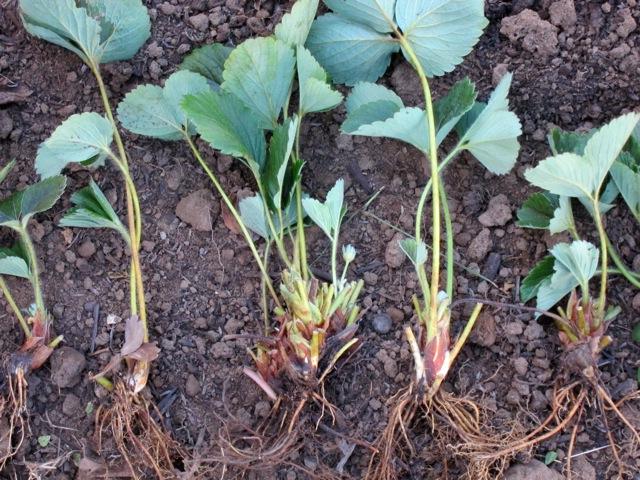

At the time of harvesting strawberries, bushes are selected, which will later be used for dividing into individual seedlings. Selected bushes, after harvesting, are covered with compost or rotted humus.
At the same time, the roots of plants begin to develop actively, which later contributes to the rapid rooting of seedlings after transplanting them to a new place.
Overgrown plants are dug out together with an earthen clod. The soil is carefully separated from the roots. The bushes are placed in a container with water. When soaked, the horns are separated from each other using a sharp, disinfected knife.
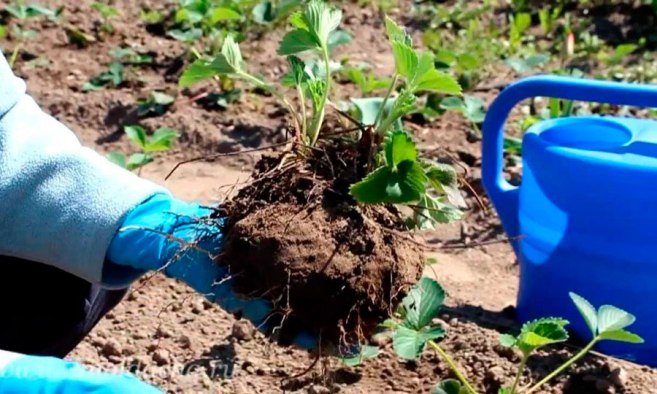

Dry leaves, shoots, peduncles and old roots are removed from each detached horn. The seedling should have 2 young stems with light roots.
The roots are dipped in a clay mash, consisting of 3 parts of clay, 1 part of manure and water (water is added until the mixture is creamy).
Instead of a chatterbox, you can use a solution of, a teaspoon of copper sulfate and 3 tablespoons of table salt per bucket of water. Plant roots are soaked in this solution for 1 hour.
Prepared seedlings are laid out in the holes. The roots are sprinkled with earth, lightly tamped and watered with settled water from a watering can. The soil around the plants is lined with a layer of vegetable mulch or dry soil.
Strawberry care
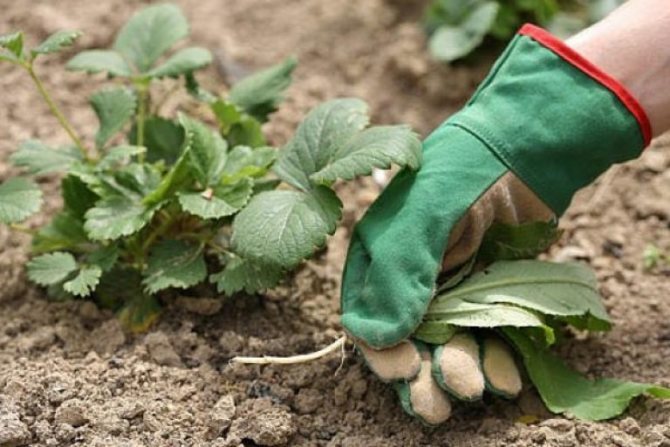

Continued care of strawberries will ensure a good harvest in the future.
After planting, the plants need to be well cared for. Proper watering, pruning and pest control will allow the root system to grow stronger. In this case, the plant will survive the cold and will delight with fresh berries for several years.
After transplanting, each bush must be watered 3 times a week. Watering must be carried out at the root of the plant. It is better to choose warm water that has settled for a while. It is not recommended to get liquid on the leaves and the outlet. In two weeks, the plant will get stronger and the amount of watering is reduced. It is important to keep the soil moist and loosened.
Pruning leaves at first is not required. It is necessary for the bush to form. Attention needs to be switched to antennae and peduncles. They need to be cut at the base. A weakened plant should direct all nutrients to the formation and strengthening of the root system. Additional shoots will deplete the bush.
Pests and diseases can damage the root system and lead to death, so it is important to take urgent action at the first sign. To get rid of the larvae and insects, you need to prepare a mixture. The composition contains 10 liters of warm water and 3 tablespoons of karbofos. The solution must be carefully treated with a bed and covered with an airtight material. For diseases and fungal infections, a solution of Bordeaux liquid is suitable. Copper oxychloride can be used.
To prepare the bushes for winter, you must first mulch the soil. Needles are suitable for this procedure. It will scare away pests and protect against diseases. Further, the sprouts are covered with a protective layer of no more than 4-5 cm in height. Suitable material for shelter: sawdust, foliage, straw, peat. This shelter will protect you from frost and will also allow the sprouts to breathe.
Planting strawberries in autumn is better than spring
Cons of planting strawberries in spring
Planting strawberries in autumn is recognized as the most fruitful. Unlike spring strawberries, planted before winter will give a decent harvest in spring. Why is the autumn planting of strawberries better than spring ones, you ask ?! The fact is that when planting strawberries in the spring, it is difficult to meet the deadlines. The soil moves away from frost, is saturated with moisture and it is simply not possible to go out into the garden. You have to wait until moisture evaporates from the soil and it will be possible to process it. This can take more than one month. And if spring rains are frequent, then planting is postponed for two, or even three months. Until early summer. Together with it, the temperature rises and the heat sets in.
In such conditions, strawberries are stressed and very sick. In my practice, it was such that out of 100% planted strawberries, only 60% took root over the summer. The strawberry root system developed very hard. This despite the fact that I watered it abundantly and often, and also covered it with agrofibre. Those bushes that took off gave a mustache, but they were very weak. That is, the season was lost for me, since I failed to multiply strawberries that year. I had to buy new seedlings and plant them in “bald spots” to replenish the rows. I no longer plant strawberries in the spring, but many are very successful at this. Thanks to the climate. Therefore, experiment.
Pros of planting strawberries in autumn
But if you meet the deadlines and plant strawberries in the fall, such problems are no longer observed. Strawberries are very well accepted and in winter they leave with a developed root system. The reason is this. Strawberries are planted in autumn when the heat has already lost ground. The temperature drops and it starts to rain. The soil in which the strawberry roots are already "sitting" is constantly moist. Thus, the plant develops in a comfortable environment. Strawberries, before the onset of stable frosts, have time to build up a powerful root system and calmly go into winter. In the spring, with the first warming, strawberries wake up and the root system begins to absorb nutrients from the soil very quickly, thereby nourishing the plant.
The warmer the soil and air become, the faster the development of the strawberry bush proceeds. The leaves become powerful and rich. This is very noticeable. Almost every day you can see how the strawberry bush becomes more powerful. When a strawberry is planted in the fall, it sprouts earlier. Consequently, the berry is formed and ripens much earlier. There is every chance of an early harvest. Here I can boast. I pick strawberries a week and a half earlier than all my neighbors. So I am doing everything right and my work is not in vain.
Let's fix: for a successful planting of strawberries in the spring, the soil must be prepared in the spring, otherwise there will be a delay in planting due to precipitation. Strawberries are planted in autumn in prepared (in August-September) soil - until the heavy rains begin.
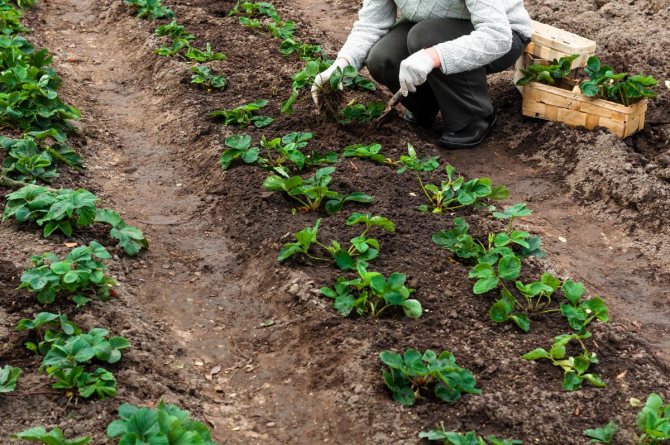

Planting strawberries in autumn
Useful Tips
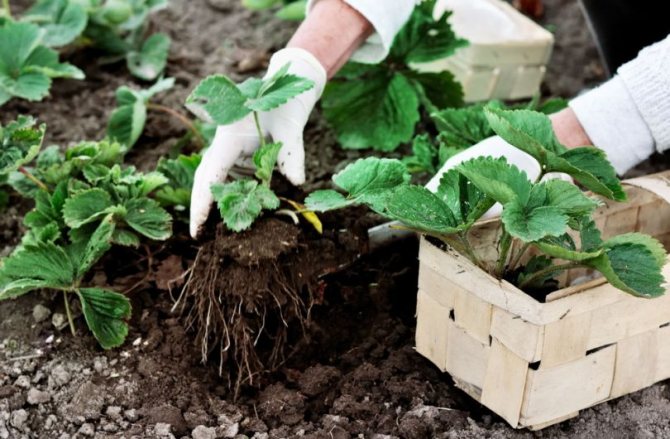

The main advice for transplanting is the careful handling of plant roots.
There are recommendations from experienced gardeners:
It is recommended to plant about 3 weeks before the onset of frost. In this case, the strawberries will be able to get stronger. It is best to transplant strawberries on a cloudy day or in the evening. Sunlight can damage young plants.
It is not recommended to plant during or immediately after rain. Let the soil dry for several hours. If the plant is planned to be propagated with a mustache, then it is recommended to plan planting in early September.
The subsequent strawberry harvest depends on the correctly chosen place, soil and seedlings. Rosettes from adult plants that previously bore fruit should not be chosen. They will not give a good harvest in the future.
In the absence of high-quality seedlings on the site, they can be purchased in nurseries or asked from neighbors.It is advisable to plant different varieties so that there is a delicious harvest all season.
Popular bugs
Often, even experienced gardeners make mistakes when transplanting strawberries, consider the most important of them:
- Planting the plants too early. As a result, the roots die from frost, and the plants no longer recover.
- Transplanting unprepared seedlings into open ground. If the bushes were growing in good conditions, then wait for stable warm days or make a safe shelter for the seedlings.
- Use as a covering material of polyethylene film. Because of this, plants often suffer from overheating.
Features of work
To begin with, it is important to determine exactly where the strawberry bushes will be transplanted. To do this, you must first prepare the soil mixture. It is important to consider that the plant must be transplanted in a new location.
The soil in the place of the old bed is freed from rhizomes, disinfected and taken away for growing other plants.
Site preparation
The best place to plant a strawberry bush will be an area with a slight slope. If you cannot find such a place, it is better to use a flat space, having previously protected it from strong winds. For the best lighting, it is best to select areas on the east or west side.
Strawberries should not be grown in shady places, lowlands, where a large amount of water accumulates in spring after snowmelt or precipitation. Groundwater should lie at a depth of no more than 1.5 m. Do not plant the plant at heights with strong evaporation of moisture and excessive dryness of the soil.
We suggest you familiarize yourself with: Marinade for cabbage without oil for the winter
Preceding crops for strawberries can be:
- onion;
- carrot;
- greens and salad;
- garlic;
- legumes.
After the nightshade plants, which take all the vitamins and minerals from the soil and often get sick, strawberries can be planted only after a year. Prior to this, it is important to carefully process the site and disinfect it from infections and parasites. Strawberries react negatively to growth in peat, clay, sod-podzolic, and acidic soils. The acidity index of the soil should vary from 5 to 5.5.
It is important to prepare the soil mixture at least a few weeks before planting the plant in a new place. If a transplant is planned in the spring, the bed is carefully prepared in the fall. The soil in this place is dug up, weeds and debris are removed from it. The following minerals are introduced into the soil per 1 m²:
- 60 g superphosphate;
- 15 g of potassium sulfate;
- 5 kg of compost or manure;
- 25 g of ammonium sulfate.
The day before planting the plant, the garden bed is thoroughly watered. To ensure a quick and good formation of a strawberry bush, its width should be 40-50 cm, and the total distance between the rows should be at least 30 cm.The total height of the garden bed can vary from 20 to 50 cm.
Procedure
For transplanting, it is best to use shrubs no older than 2 years. They must have good and strong roots up to 5 cm long and leaves about 4 cm. They are removed from the soil mixture before planting in a new place, all diseased and deformed stems are removed.
When creating a hole for planting a seedling, it is important to consider the location of the root collar of the bush. It should be level with the ground. Deepening of this part of the plant can lead to clogging of the growing point, and insufficient depth can expose the rhizomes. In these cases, the culture may not take root and die. The total distance between the holes should be up to 40 cm.
The seedling is carefully transferred to the planting hole, the root system of the plant is straightened around the perimeter and sprinkled with drainage. The surface is well compacted and poured with 3 liters of water at room temperature. The trunk circle can be mulched with humus or peat mixture.
For correct reproduction, you can use not only the first outlet - according to their genetic characteristics, they are all identical to the mother's culture. However, in this case, the rosettes of the third and second order are not so well formed - the first fruiting will be delayed. In the future, they will not differ from the bushes transplanted from the first outlet.

